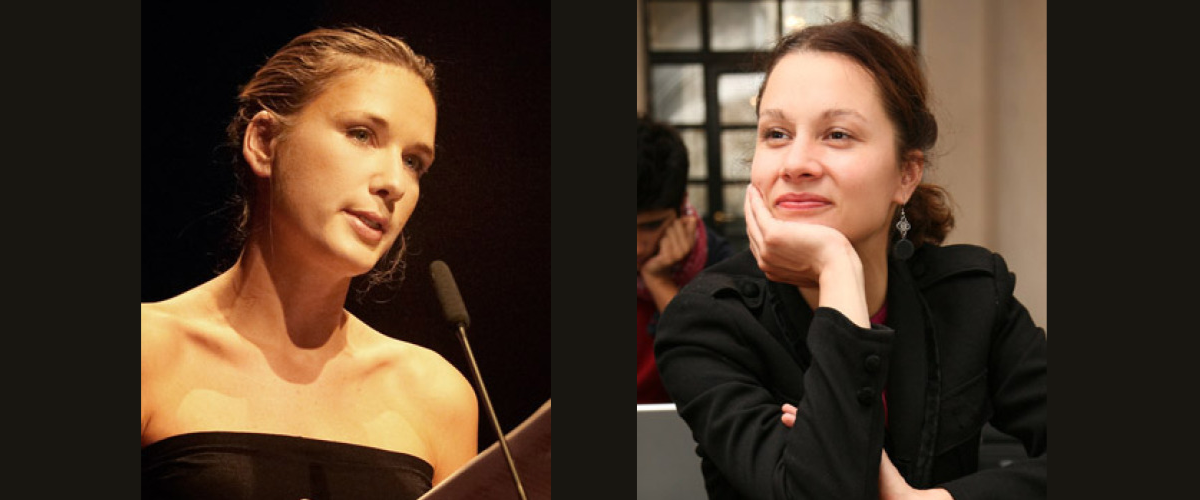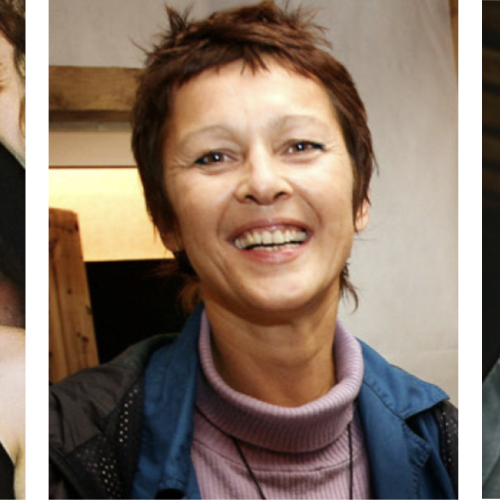



Interview with Dunja Kukovec and Katja Kobolt
In the third interview marking the 30th anniversary of the City of Women festival, where we explore different approaches to feminist curation, we spoke with Katja Kobolt and Dunja Kukovec, who curated the 13th and 14th editions and designed the program for the 15th City of Women festival.
City of Women: Dunja and Katja, how did your journey with the City of Women begin? How does your story start?
Dunja Kukovec: My story starts with Sabina Potočki. I came from the field of new media and contemporary art, and at that time, the (new) media revolution was coming to an end, creating a sort of vacuum. There was a lot of talk about open society and inclusivity. Sabina Potočki noticed me in this context. She was (and still is) a master of connecting people—not just in a curatorial sense but on multiple levels. She noticed both Katja and me in different contexts; at that time, we didn’t know each other, and she was the one who brought us together. It was a real burst of energy. You could immediately feel the excitement and the potential to do meaningful work. My first transformative impulse had come from the new media world, but at that point, there was a political void. The City of Women opened up a new field for me—feminism—which overlapped with my academic and theoretical background. I have always been interested in non-linear curatorial awareness and saw this position as both creative and artistic. The application of art theories was always present, and it required implementing different ways of thinking. So, I would describe these beginnings as transformative and full of community energy. It was all about collective consciousness.
Katja Kobolt: At that time, the central question revolved around the body. When I read Jasmina Tumbas' book, I found it interesting from a theoretical perspective that it never explicitly addresses the question of the body. In the 1990s, this was a key question in feminist theory and practice (not just in performance art): How do we conceptualize bodily freedom? The idea of a liberated body, supposedly free from collective constraints, had already, in the alternative movements of the 1980s, led to a kind of blindness regarding which structures were being sacrificed for this freedom. Back then, the paradigms of bodily freedom and open code were dominant, and people believed in their democratic potential.
City of Women: The festival editions often focused on different themes. How did you decide on the topic of each edition?
Katja Kobolt: Within a given topic, we each brought our overarching proposals. For example, with the burlesque group The Burlesque Hour, involving Australian and British performers who later returned to conduct workshops. That was an initial moment for Ljubljana’s queer burlesque scene. We sought ways to activate the festival as a generative moment for the local community itself.
“We sought ways to activate the festival as a generative moment for the local community itself.”
Dunja Kukovec: The theme never served as a way to exclude anyone; it was merely an impulse for the festival’s overall message. Beyond expanding the question of what art is and can be, we wanted to go beyond a purely critical stance. We weren’t interested in moralizing but in action—figuring out where our power lies and creating from there.
“We weren’t interested in moralizing but in action—figuring out where our power lies and creating from there.”
Katja Kobolt: What Dunja said is crucial: moving beyond a purely critical art position, beyond art that merely dissects and presents the current situation. What interested us—later also in the trans-Yugoslav curatorial collective Red Min(e)d—was art as a generative moment for themes and forms that are important and relevant. Because of this, we were sometimes criticized for not choosing themes that had already been accepted as feminist by public perception. Within City of Women, we still adhered to the paradigm of so-called “women’s authorship,” not because this art was inherently different, but because the conditions for artistic work based on gender were (and still are) different, mostly worse. In short, we sought moments where feminism manifests as a community practice.
Dunja Kukovec: We found it important to preserve the materiality of gender—that remains important today.
Katja Kobolt: The reference to the shared Yugoslav space was also significant. We didn’t want to abandon the common framework of artistic and socio-historical context. The Slovenian cultural and artistic system is highly monocultural, but the question of who gets to co-define culture and art is important. At the same time, City of Women was one of the first and probably rare organizations that structurally opened up to new collaborators—even though those of us who left ended up in precarious positions.
Dunja Kukovec: I would also emphasize that ensuring fair pay for artists was very important to us. Additionally, we considered geopolitical factors—where artists came from and where they worked.
City of Women: You also worked on projects outside the festival. What was your perspective on the annual program and European projects? Was there a reason beyond financial necessity to keep working continuously?
Dunja Kukovec: We questioned everything, including the impact of an event that happens once a year and what would happen if that changed. Would it enhance the effect, or run parallel to it? I never saw these projects as competing with the festival, but as a way to promote it.
Katja Kobolt: The festival format has its specific time-space dynamic. In the 1990s, it had a carnivalesque nature. But in the 2000s, the question arose: positions were occupied, those from the 1980s had established public institutions and associations, while our transitional generation was seen as the “loser” generation because we lacked production infrastructure. We tried to secure more funding, but quickly realized that more money meant more work, without necessarily improving working conditions. We wanted to collaborate with local artists, but the frustration of poor working conditions remained. It was difficult to create conditions where collaboration truly benefited everyone—supporting artists both in content and in fair working conditions. Otherwise, you’re just reproducing the precarious conditions that most artists already endure. That was a major frustration.
Dunja Kukovec: This creates a trap—it’s still a danger today—because when you increase funding, you also have to expand production, meaning more projects, but that doesn’t necessarily improve working and living conditions.
City of Women: What about media coverage? What was the climate like back then?
Katja Kobolt: In the late 1990s, feminism in the media was heavily criticized, with a narrow understanding of what it meant. The climate was different—it’s not like today, when even high school students openly identify as feminists. Back then, many female artists resisted having their work labeled as feminist. This is why we didn’t explicitly present the entire festival and program as feminist. Even now, there are ongoing debates about what feminist art actually is—it’s not a straightforward concept. Why should we call something feminist art just because of the artist’s gender? However, I do agree with my Marxist feminist colleagues who say that there is only one feminism—the kind that actually helps people, especially women, who are multiply burdened, making their lives here and now a little easier.
City of Women: How do you see City of Women today, compared to before?
Dunja Kukovec: We must be careful not to fall into a trap. The harder things get, the more important the work becomes. I appreciate that City of Women persists, but we also need to think creatively and avoid getting stuck in just a critical position. Art must continue moving forward—beyond space, deep inside, all the way to the core of the earth, into the heart… We must be mindful of these traps.






